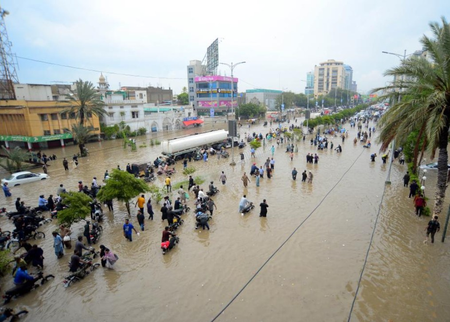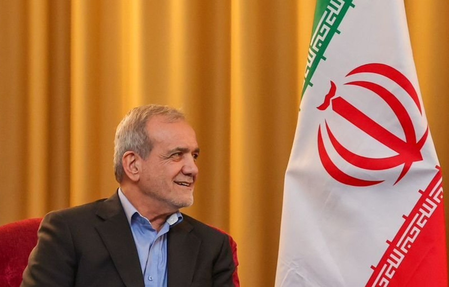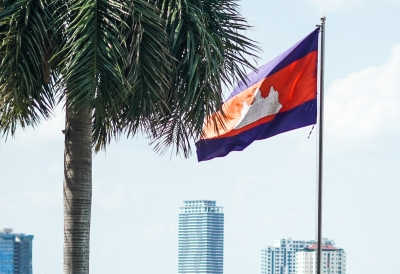
Karachi, Aug 24 (IANS) The recent torrential rains have once again exposed the chaotic and fragmented governance of Karachi, with the widespread flooding reviving the confusion on which agency or municipal body is responsible for basic services, further causing anger among people and leading to debates regarding how the city is governed, as per a report.
Karachi’s ranking as the fourth least liveable city in the world, 170th out of 173 cities, in the 2025 Economist Intelligence Unit’s Global Liveability Index showcases its ongoing liveability crisis. Political fragmentation and neglect have systematically weakened Karachi, and it is visible everywhere: in collapsing infrastructure, inadequate services and declining quality of life, Pakistan-based The News International said in a report.
The 2025-26 budget of Karachi Metropolitan Corporation is (Pakistani) Rs 55 billion ($196 million). Further adding multiple agencies, DHA, cantonments and provincial departments, the citywide spending is estimated at $300 million to $500 million, though a lack of transparency makes it difficult to get a clear fiscal picture of the city. As Karachi has a population of 20 million, this amount translates to just $14.7 to $25 per person annually. This underfunding causes failing services, crumbling roads and water shortage.
Karachi’s economic and service challenges are exacerbated by unorganised urban planning, Yousuf Nazar, former head of Citigroup’s emerging markets investments, wrote in an opinion piece in The News International. It has transformed into a concrete jungle due to widespread corruption, unchecked real-estate development, and the lack of a strong local governance system. In addition to the city’s planning failure, the Karachi Building Control Authority (KBCA), tasked with regulating construction and implementing safety codes, has been hindered for years due to incompetence, corruption, and poor enforcement. As many as 27 people were killed after a five-storey building in Lyari collapsed in July this year.
The DHA and cantonment boards control the affluent areas – DHA sees about 36 square kilometres (one per cent of Karachi), Malir Cantonment about 12 square kilometres – with the six cantonments and DHA together managing 20–30 per cent of the city while the Pakistan Peoples Party (PPP)-led Sindh government which has been in power since 2006 oversees the remaining 70–80 per cent. It is responsible for the chronic failures and development decay of the city.
Fragmentation further affects governance, with each municipal or cantonment body functioning independently, with little coordination to allow economies of scale, shared investments or strategic planning. It causes duplicated duties, conflicting priorities and weak accountability. Many term the fragmented governance of Karachi as little more than the division of territory among powerful stakeholders, The News International report said.
The underrepresentation of Karachi in politics further causes the city’s neglect. Karachi elects 22 of Pakistan’s total National Assembly members (266) on general seats, and 47 of Sindh’s 130 provincial assembly members on general seats, yet it has only two federal cabinet seats (out of 43) and two provincial ministries (out of 18). This imbalance lowers the influence of the city in decisions regarding budgets and reforms, despite its economic and demographic importance.
Karachi’s failures can also be seen in the water supply. The Karachi Water and Sewerage Corporation (KWSC) supplies around 423 million gallons per day, barely one third of the required 1,080–1,200 MGD, resulting in residents relying on over 10,000 water tankers, many controlled by a ‘tanker mafia’ accused of taking off an estimated 272 MGD, or 41 per cent of the city’s supply, Nazar wrote in The News International report.
Furthermore, Karachi loses 30–40 per cent of piped water due to leaks from an ageing network. Every day, Karachi experiences gridlocked traffic, collapsed waste management and inadequate storm drainage that causes floods with each monsoon. Climate risks further exacerbate these crises: heatwaves and intense storms threaten millions of residents.
Affluent neighbourhoods in Karachi enjoy superior services and infrastructure, while middle and lower-income areas face relentless decay and neglect. The Clifton Bridge separates these privileged areas from the rest of the city. Years of neglect, dysfunction and underfunding have brought Karachi to the brink.
Without bold reforms, increasing funding, and unified governance, Karachi is facing collapsing infrastructure, increasing inequality, and growing unrest, the report said.
–IANS
akl/vd




